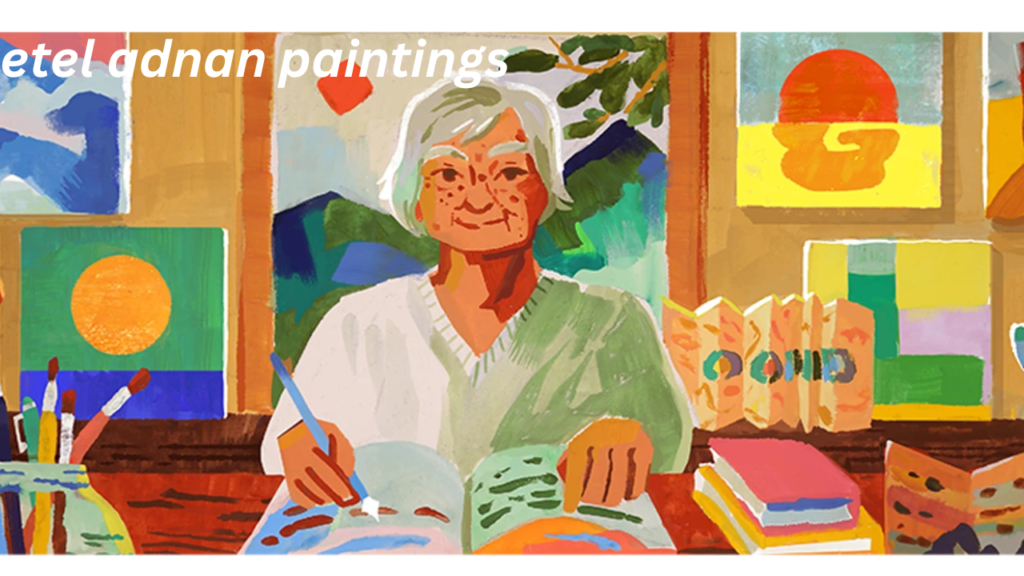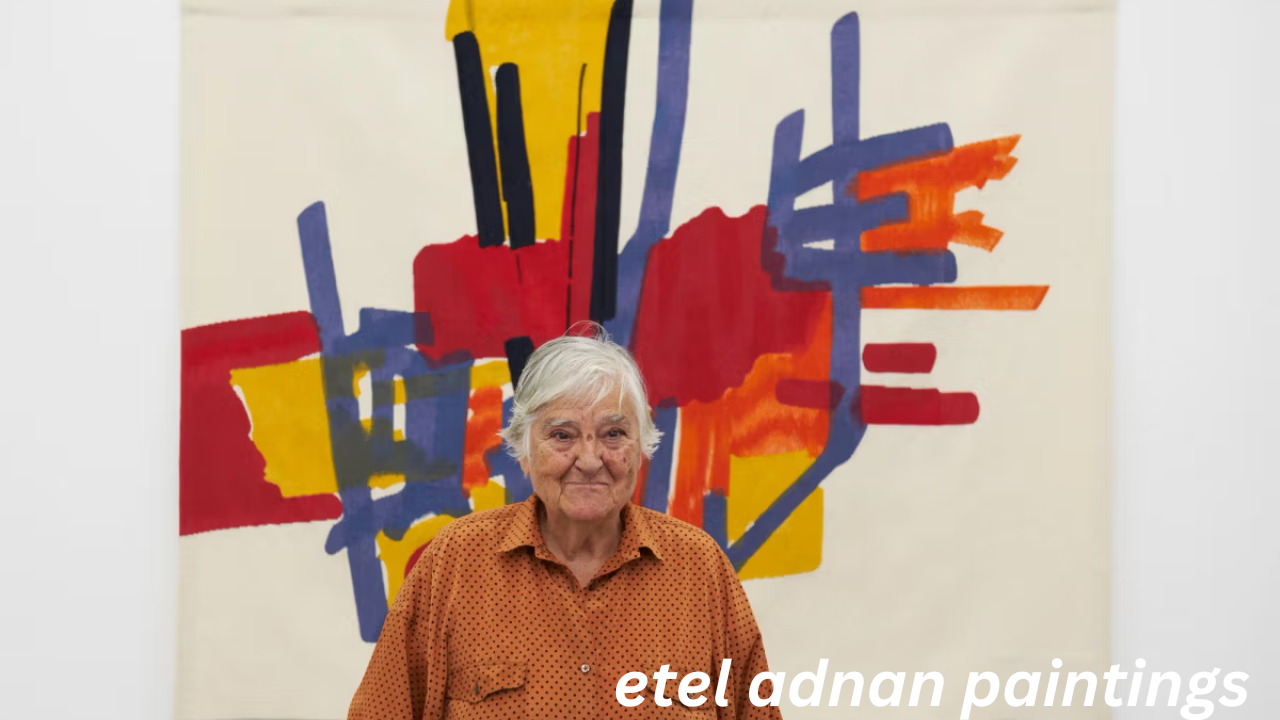etel adnan paintings as one of the most unique and influential voices in contemporary art, known for her stunning paintings, as well as her literary works. Born in Beirut in 1925 to a Greek mother and a Syrian father, Adnan’s life was defined by displacement, both literal and emotional. Her paintings, which are deeply tied to her rich cultural heritage and personal etel adnan paintings, serve as a vivid extension of her worldviews—often abstract yet profoundly expressive. In this article, we delve into the world of Etel Adnan’s visual art, exploring her journey from a writer to a painter, the distinctive elements of her artistic style, the major works that define her legacy, and the etel adnan paintings ideas that underpin her creations. Ultimately, we will examine how her works continue to resonate in today’s global cultural landscape.
Etel Adnan: A Multidisciplinary Visionary

Early Life and Cultural Influences
Etel Adnan’s artistic journey was profoundly shaped by her early years in Beirut, which was a melting pot of cultures, languages, and political upheaval. Growing up in the midst of a diverse yet tumultuous environment, Adnan was exposed to a unique etel adnan paintings, Syrian, and Lebanese influences. This multi-layered cultural backdrop played a key role in shaping her identity and, by extension, her art. The deep connection she felt to the Mediterranean landscape and the various places she called home would later inform much of her visual work.
Her formative years also included exposure to the intellectual circles of Beirut and Paris, where she moved to study philosophy at the Sorbonne. As a thinker and writer, Adnan was deeply influenced by the political and social climates of the Middle etel adnan paintings writings explore themes of displacement, identity, and the complexities of cross-cultural experiences, which would later echo in her visual art. It was during this time that she began to experiment with painting, using it as a way to express emotions and ideas that language alone could not fully capture.
Transition from Writing to Visual Art
Etel Adnan’s transition from a writer to a painter was not abrupt, but rather a natural evolution of her creative expression. In the 1960s, while still living in Paris, she began experimenting with painting, using it as an alternative means to articulate her inner world. While her poetry and prose were rich with imagery, the physicality of paint offered her a more direct, intimate connection to her emotional landscape. Adnan’s approach to visual art was deeply etel adnan paintings philosophical musings, with each painting serving as a form of contemplation on time, place, and existence. This shift marks the beginning of Adnan’s exploration of color and abstraction, themes that would define her painting style for the rest of her career.
The Artistic Style of Etel Adnan
Mediums and Techniques
Adnan’s medium of choice was often oil on canvas, though she was not limited to any one technique. Her artworks are particularly known for their striking use of bold colors and geometric forms. One of her most iconic works, the Mount Tamalpais series, features a combination of swirling, abstract landscapes with bright colors that evoke both serenity and tension. Her smaller-scale paintings and leporellos (accordion-style books) further allowed her to explore the dynamic relationship between space and form. Adnan also experimented with tapestries, creating textured, large-scale works that brought an added dimension to her exploration of visual space.
The simplicity and clarity of her compositions are deceptive. Although the shapes are often minimalist, there is a remarkable depth in the way she arranges colors, suggesting both movement and stillness. The swathes of bright oranges, blues, yellows, and reds evoke the shifting colors of the sky, land, and water, while the lack of overt detail allows viewers to immerse themselves in the emotional weight of each piece.
Symbolism and Meaning in Her Paintings
Etel Adnan’s paintings are imbued with symbolism, often drawing inspiration from nature, landscapes, and her own experiences of exile. One of the most recurring motifs in her work is the mountain, particularly the one closest to her heart—Mount Tamalpais in California. For Adnan, the mountain was not just a physical object but a symbol of permanence, continuity, and the cycles of life. In many of her works, the mountain appears as an abstracted form, with broad strokes of color that evoke both the physicality of the landscape and the emotional resonance it held for her.
The sun, too, is a recurring figure, often represented as a glowing orb in her compositions. For Adnan, the sun was not merely a celestial body but a metaphor for life and energy. By using abstract forms, she imbued the sun with emotional depth, representing both a source of light and warmth, as well as the harshness of time’s passage. Her works are not just representations of nature; they are emotional landscapes where color and form converge to tell stories of identity, belonging, and loss.
Dialogue Between Text and Image
Adnan’s artistic language is not confined to the visual alone. Her paintings often work in tandem with her poetry, with many of her leporellos blending written text and visual imagery. This hybrid approach to art blurs the lines between language and painting, allowing her to convey complex ideas through both mediums simultaneously. In these works, Adnan’s calligraphy-style writing—fluid, expressive, and often abstract—becomes part of the composition, emphasizing the intertwined relationship between the visual and the verbal. Her paintings and poems together invite viewers to engage in a dialogue about the nature of language, perception, and meaning.
Major Works and Exhibitions
Notable Paintings and Series
Etel Adnan’s Mount Tamalpais series remains one of her most celebrated works. These paintings feature sweeping landscapes that capture the vastness of the California landscape, where Adnan lived for many years. The undulating lines and vibrant colors in these works reflect the dynamic and ever-changing qualities of nature, while also capturing the artist’s personal connection to the land.
In addition to the Mount Tamalpais series, Adnan’s abstract landscapes and cityscapes often evoke the sense of an inner journey—one that traverses not only physical space but also psychological terrain. Her depiction of cities, particularly her representations of Beirut, draw on her experiences of war and exile, incorporating fragmented forms that suggest a world in flux. These works are as much about memory and loss as they are about the present moment.
Landmark Exhibitions and Recognition
Throughout her career, Adnan’s work was featured in major exhibitions around the world. Notably, her participation in Documenta 13 in Kassel, Germany, brought her work to a global audience, showcasing her paintings alongside those of other influential contemporary artists. She has also had solo exhibitions at prestigious institutions such as the Serpentine Gallery in London, the Guggenheim Museum in New York, and the San Francisco Museum of Modern Art (SFMoMA). These exhibitions helped solidify her reputation as a pioneering force in contemporary abstract art.
Influence on Contemporary Art Scene
Adnan’s work has had a profound influence on the contemporary art scene, particularly in the way it bridges the gap between Western and Middle Eastern artistic traditions. Her unique ability to combine abstraction with personal and political meaning has resonated with younger generations of artists who see her as a beacon of visual and intellectual freedom. Her art continues to inspire new conversations around identity, exile, and the role of the artist in times of conflict.
The Philosophy Behind Her Visual Language
Nature, Identity, and Exile
For Adnan, art was not just a form of expression—it was a way to navigate her complex identity as a woman caught between cultures and worlds. Born in Lebanon to a Syrian father and Greek mother, her experience of cultural hybridity and exile became central to her understanding of space and belonging. The motifs of mountains, landscapes, and suns in her work are often interpreted as representations of her own search for stability and grounding, amidst the chaos of war and displacement.
Political Dimensions of Her Work
Many of Adnan’s paintings carry deep political weight, particularly in their engagement with themes of war and displacement. The abstract nature of her work often provides a subtle yet potent commentary on the effects of war and the fragmentation of identity. For Adnan, art became a tool of resistance—an act of reclaiming space and voice in the face of violent erasure. Her work speaks to the resilience of the human spirit, and to the enduring hope that art, in its purest form, can transcend the devastation of political conflict.
Spiritual and Existential Underpinnings
Underlying all of Adnan’s work is a deep spiritual quest. Many critics have described her paintings as meditative, with their vibrant colors and abstract forms inviting contemplation. Adnan’s use of color is not simply aesthetic; it reflects her engagement with the deeper questions of existence, time, and the relationship between the self and the universe. In this sense, her paintings are not just visual experiences—they are philosophical meditations on the nature of life, death, and everything in between.
Conclusion
Etel Adnan’s paintings represent more than just colorful abstractions; they are windows into the mind of an artist who experienced the world in its most raw and powerful form. Her work transcends geographical and cultural boundaries, speaking to universal themes of identity, memory, and survival. Adnan’s legacy is one of profound depth and resonance—her art offers not only aesthetic beauty but a philosophical exploration of the human condition. As we reflect on her body of work, it is clear that Adnan’s visual language continues to inspire and challenge us to think more deeply about the spaces we inhabit, both physically and emotionally.
You May Also Read: https://ventsworlds.com/the-raven-queen/

